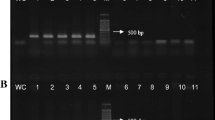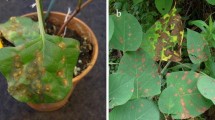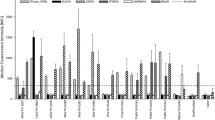Abstract
Six primers based on the sequence of the flanking and coding regions of the elicitin gene ParA1 of Phytophthora nicotianae were tested for specific detection of the fungus by the polymerase chain reaction (PCR). One combination, IL7/IL8, with IL7 in a flanking region and IL8 in a coding region of the gene, gave an intense 378 bp signal with a diverse collection of isolates of P. nicotianae, that included some from black shank disease of tobacco and others from a variety of hosts. The sequence of the amplification product obtained with an isolate that produces elicitin and one that does not, was homologous with the known sequence of the ParA1 gene. The same primer combination gave no signal with sixteen other Phytophthora species tested except for two isolates P. palmivora with which it gave a weak 800 bp signal. It gave no signal with DNA from healthy tobacco and tomato plants but P. nicotianae was detected in inoculated tobacco and tomato plants. Small numbers of zoospores (>100) trapped onto a nitrocellulose membrane after filtration from suspension were also detected after two successive rounds of PCR.
Similar content being viewed by others
References
Ali-Shtayeh MS, MacDonald JD and Kabashima J (1991) A method for using commercial ELISA tests to detect zoospores of Phytophthora and Pythium in irrigated water. Plant Disease 75: 305–311
Bruce KD, Hiorns WD, Hobman JL, Osborn AM, Strike P and Ritchie DA (1992) Amplification of DNA from native population of soil bacteria by using the Polymerase Chain Reaction. Applied and Environmental Microbiology 58: 3413–3416
Cahill DM and Hardham AR (1994a) A dipstick immunoassay for the specific detection of Phytophthora cinnamomi in soils. Phytopathology 84: 1284–1292
Cahill DM and Hardham AR(1994b) Exploitation of zoospores taxis in the development of a novel dipstick immunoassay for the specific detection of Phytophthora cinnamomi. Phytopathology 84: 193–200
Devergne JC, Fort MA, Bonnet P, Ricci P, Vergnet C, Delaunay T and Grosclaude J (1994) Immunodetection of elicitins from Phytophthora spp. using monoclonal antibodies. Plant Pathology 43: 885–896
Edwards K, Johnstone C and Thompson C (1991) A simple and rapid method for the preparation of plant genomic DNA for PCR analysis. Nucleic Acids Research 19
Ersek T, Schoelz JE and English JT (1994) PCR amplification of species-specific DNA sequence can distinguish among Phytophthora species. Applied and Enviromental Microbiology 60: 2616-
Goodwin PH, English JT, Neher DA, Duniway JM and Kirkpartrick BC (1990) Detection of Phytophthora parasitica from soil and host tissue with a species-specific DNA probe. Phytopathology 80: 277–281
Hall R, Zentmeyer GA and Erwin DC (1969) Approach to the taxonomy of Phytophthora through acrylamide gel electrophoresis of proteins. Phytopathology 59: 770–774
Hauswirth WW, Dickel CD and Lawlor DA (1994) DNA analysis of the windover population. In: Herrmann B and Hummel S (eds) Ancient DNA. Recovery and Analysis of Genetic Material from Paleontological Archeological, Museum, Medical and Forensic Specimens (pp. 104–121) Springer-Verlag, New York USA
Hickman CJ (1958) Phytophthora plant destroyer. Transactions of the British Mycological Society 41: 1–13
Ho HHand Jong SC (1989) Phytophthora nicotianae (P. parasitica). Mycotaxon 35: 243–276
Huet JC, Le Caer JP, Nespoulos C and Pernollet JC (1995) The relationships between the toxicity and the primary and secondary structures of elicitin-like protein elicitor secreted by the phytopathogenic fungus Pythium vexans. Molecular Plant-Microbe Interaction 8: 302–310
Hummel S and Herrmann B (1994) General aspects of sample preparation. In: Herrmann B and Hummel S (eds) Ancient DNA. Recovery and Analysis of Genetic Material from Paleontological Archeological, Museum, Medical and Forensic Specimens (pp. 59–68) Springer-Verlag, New York USA
Jones K and Shew HD(1988) Immunoassay procedure for the detection of Phytophthora nicotianae var nicotianae in soil (abstr.). Phytopathology 78: 1577
Kamoun S, Klucher KM, Coffey MA and Tyler (1993)Agene encoding a host-specific elicitor protein of Phytophthora nicotianae. Molecular Plant-Microbe Interactions 6: 573–581
Lacourt I (1994) Fr Etude de la spécialisation parasitaire de Phytophthora parasitica Dastur par l'analyse d'une population d'isolats d'origines géographiques diverses. Thèse de Doctorat, Université Claude Bernard of Lyon
Lacourt I, Panabières F, Marais A, Venard P and Ricci P (1994) Intraspecific polymorphism of the fungus Phytophthora parasitica revealed by the analysis of mitochondrial DNA Restriction Fragment Length Polymorphism. Mycological Research 9: 562–568
Le Berre J-Y, Panabières F, PonchetM, Denoroy L, Bonnet P, Marais A and Ricci P (1994) Occurence of multiple forms of elicitin in Phytophthora cryptogea. Plant Physiology and Biochemistry 32: 1–5
Lee SB and Taylor JW (1992) Phylogeny of five fungus-like protoctistan Phytophthora species, inferred from the internal transcribed spacers of ribosomal DNA. Journal of Molecular and Biological Evolution 9: 636–653
McDonald JD, Stites J and Kabashima J (1990) Comparison of serological and culture plate methods for detecting species of Phytophthora, Pythium and Rhizoctonia in ornamental plants. Plant Disease 74: 655–659
MacDonald JD, Ali-Shtaeyh MS, Kabashima J and Stites J (1994) Occurence of Phytophthora species in recirculated nursery irrigation effluents. Plant Disease 78: 607–611
MacManus PS and Jones AL (1995) Detection of Erwinia carotova by nested PCR and PCR-dot-blot and reverse-blot hybridisations. Phytopathology 85: 618–62
Miller SM, Petersen FP, Miller SA, Rittembourg JH, Wood SC and Grothaus GD (1989) Development of a direct immunoassay to detect Phytophthora megasperma in soil. (abstr.) Phytopathology 79: 1139
Nespoulos C, Huet JC and Pernollet JC (1992) Structure-function relationships of a and b elicitins, signal proteins involved in the plant-Phytophthora interaction. Planta 186: 551–557
Panabières F, Marais A, Le Berre JY, Fournier D, Penot I and Ricci P (1995) Characterization of a gene cluster of Phytophthora cryptogea which encodes for elicitins, proteins inducing a hypersensitive-like response in tobacco. Molecular Plant-Microbe Interactions 8: 996–1003
Picard C, Ponsonnet C, Paget E, Nesme X and Simonet P (1992) Detection and enumeration of bacteria in soil by direct DNA extraction and Polymerase Chain Reaction. Applied and Environmental Microbiology 58: 2717–2722
Ricci P, Bonnet P, Huet JC, Sallantin M, Beauvais-Cante F, Bruneteau M, Billard V, Michel G and Pernollet JC(1989) Structure and activity of proteins frompathogenic fungi Phytophthora eliciting necrosis and acquired resistance in tobacco. European Journal of Biochemistry 183: 555–563
Ricci P, Trentin F, Bonnet P, Venard P, Mouton-Perronnet F and Bruneteau M (1992) Differential production of parasiticein, an elicitor of necrosis and resistance in tobacco, by isolates of Phytophthora parasitica. Plant Pathology 41: 298–307
Ricci P, Panabières F, Bonnet, Maia N, Ponchet M, Devergne JC, Marais A, Cardin L, Milat ML and Blein JP (1993) Proteinaceous elicitors of plant defense responses. In: Fritig B and Legrand M (eds) Mechanisms of Plant Defense Response (pp. 136–139) Kluwer Academic Publishers, The Netherlands
Sambrook J, Fritsch EF and Maniatis T (1989) Molecular Cloning, a Laboratory Manual. Second Edition. Nolan C and Ferguson M (eds) Cold Spring, Harbor Laboratory Press
Stamps DJ, Waterhouse GM, Newhook FJ and Hall GS (eds) (1990) Revised tabular key to the species of Phytophthora.Mycological Paper No 162, 28 pp. C.A.B. International Mycological Institute
Toranzos GA and Alvarez AJ (1992) Solid-phase polymerase Chain Reaction: Application for direct detection of enteric pathogens in water. Canadian Journal of Microbiology 38: 365–369
Tsao PH (1983) Factors affecting isolation and quantitation of Phytophthora from soil. In: Erwin DC, Bartnicky-Garcia S and Tsao PH (eds) Phytophthora, Its Biology, Taxonomy, Ecology and Pathology (pp. 219–236) American Phytopathological Society, St Paul, Minnesota
Tucker CM (1931) taxonomy of the genus Phytophthora de Bary. Missouri agricultural Experiment station Research Bulletin 153: 1–208
White TJ, Bruns T, Lee S and Taylor J (1990) Amplification and direct sequencing of fungal ribosomal RNA genes for phylogenetics. In: PCR Protocols: A Guide to Methods and Applications (pp. 315–321) Academic Press Inc. New York
Yu LM (1995) Elicitins from Phytophthora and basic resistance in tobacco. Proceedings of National Academy of Sciences 92: 4088–4094
Author information
Authors and Affiliations
Rights and permissions
About this article
Cite this article
Lacourt, I., Duncan, J.M. Specific detection of Phytophthora nicotianae using the polymerase chain reaction and primers based on the DNA sequence of its elictin gene ParA1. European Journal of Plant Pathology 103, 73–83 (1997). https://doi.org/10.1023/A:1008634222146
Issue Date:
DOI: https://doi.org/10.1023/A:1008634222146




